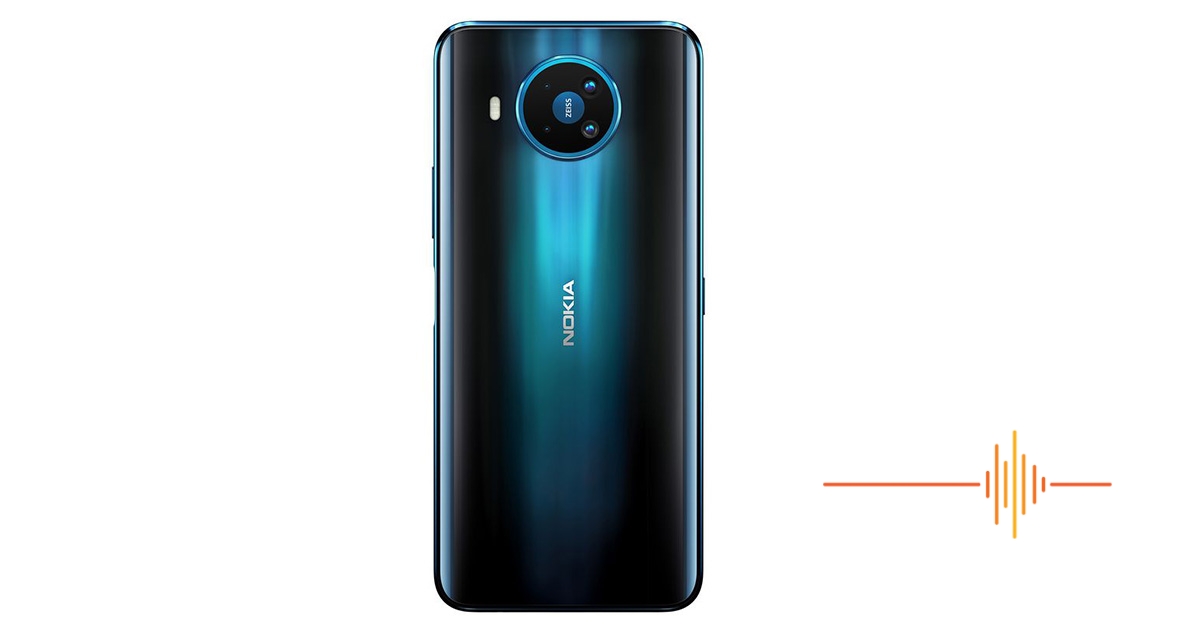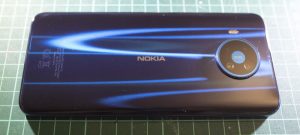 Without a doubt, Nokia was a powerhouse for mobiles back in the 90s. The “little” Finnish company dominated the scene and in all honesty lead the first charge of smartphones with Symbian OS. The arrival of the Blackberry and iPhone heralded their demise, particularly with their bull headed and delayed approach to modernise Symbian OS and competing against iOS and Android.
Without a doubt, Nokia was a powerhouse for mobiles back in the 90s. The “little” Finnish company dominated the scene and in all honesty lead the first charge of smartphones with Symbian OS. The arrival of the Blackberry and iPhone heralded their demise, particularly with their bull headed and delayed approach to modernise Symbian OS and competing against iOS and Android.
Nokia is now owned by HMD Global, with an exclusive licence to use the Nokia brand on mobile phone and tablets. DRN have reviewed a number of their handsets – the Nokia 5.3 and Nokia 800 Tough. This time around, we got our hands on their flagship, the Nokia 8.3 5G.
Given the Nokia 8.3 5G was announced back in March 2020 and has only just launched, I asked the question on what is the target audience and Nokia has indicated that it is for socially active people, content creators and family orientated people who want to empower their down time. There is No Time to Die, so let’s go and check out how the new 00 agent phone performs.
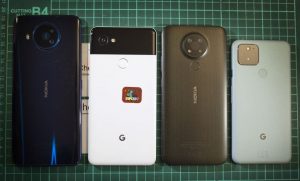 First Impressions
First Impressions
The Nokia 8.3 5G is a beast of a phone. I have had the Pixel 2XL, Pixel 4XL, Pixel 5 and the Nokia outsizes them all with it’s 6.81″ FHD display.
The phone is carved from a block of aluminium for strength, covered in a polymer composite and topped with Gorilla glass both front and back. Everything is curved and there is no gaps or sharpness anywhere. Despite the size, it feels solid in my hand and it is comfortable, if slippery, to hold in it’s native form.
The special process used to create the “refracted light” on the back of the phone resulted in a finish that is nothing short of stunning. Everyone who sees the phone in person marvels at the gorgeous Polar Night, a blue shimmer inspired by aurora borealis – the northern lights of the arctic sky, as befitting the Scandinavian heritage.
I fretted about dropping the phone during testing, but Nokia has thoughtfully provided a transparent case in the box which took care of that concern. Best of all, it does absolutely nothing to hide that beautiful back cover.
The power button is halfway down the right side of the chassis and doubles as a fingerprint sensor. The design philosophy is that a back fingerprint reader would cause balance issues for people with small hands. I have to admit it feels very natural to rest my index finger on it as I pick up the phone, so much so sometimes I unlock without intending to.
On the opposite side of the power button is a dedicated Google Assistant button.
The imaging module does protrude from the body but not ridiculously so, instead of the squarish block in a corner that most competitors use, Nokia has the optics in a circle along the mid-line at the top of the device. I will cover off the technical specifications of the optics later.
As expected the Nokia 8.3 5G has a USB-C port. It also features a 3.5mm headphone port which is missing from most competitors now.
Getting started
Turning on the Nokia 8.3 5G is a trip down nostalgia lane. When was the last time you heard the classic Nokia start up tone? Well it is back, a bit modernised but quintessentially Nokia.
One of the main reasons I have been a Nexus / Pixel fan is the pure Android experience as well as the timely updates. The Nokia 8.3 5G is a pure Android experience, without the encumbrances of custom launchers and apps like competitor phones. It is Android as pure as Google’s vision for the OS and it is a welcome change. Don’t get me wrong, every manufacturer wants to put their mark on their products, but Nokia is putting their mark on the hardware experience and there is nothing wrong with that approach.
If you have ever used an Android phone, the setup experience is the same. Follow the bouncing ball, this time without the OEM specific account requirements. Coming from the Pixel line, the transition was seamless.
00 Agent OpSec
HMD Global commissioned a report on ANZ Smartphone and Data Security. It explores the relationship Australians have with their mobile phones from security concerns, to data transparency through to the complexities of work/life balance through our phones. The key findings are interesting, and reveals:
- 52% of Australian mobile phone users are actively concerned about their phone’s security
- 37% admit they have no clue in which country their phone’s data is stored
- 28% don’t understand how manufacturers handle customer data
- 10% don’t care where their phone data is stored
Further
- 30% of Australian mobile phone owners are unsure of the importance of security patches and OS updates or claim it’s not important that their phone runs on the latest Operating System
- Only 37% of Australian mobile phone owners diligently update their device immediately when prompted
- 27% of phone owners in Australia who wait more than a week before doing so – leaving nearly 6.9 million Aussies targets for hackers
Data jurisdiction is not something your average person worries about, but in a nutshell, where is your data located, who hosts your data, under which country’s law does it fall under? All of these will affect who is allowed to access it.
Updates
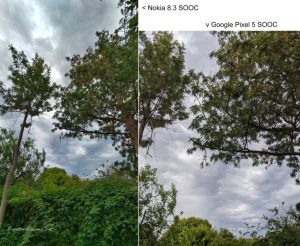 When I received the phone in the first week of November 2020, the October security update was already waiting for me to install. As I am finishing this write up on the first day of December, the November security patch just became available. So we are looking at being roughly a month behind the release of the patches from Google.
When I received the phone in the first week of November 2020, the October security update was already waiting for me to install. As I am finishing this write up on the first day of December, the November security patch just became available. So we are looking at being roughly a month behind the release of the patches from Google.
Nokia is widely acknowledged to one of the fastest manufacturers to push out updates. This claim has been independently endorsed by Counterpoint Research. In fact, the Nokia 8.3 5G is on the top of the list for first wave of Android 11 “Red Velvet Cake” update, slated for Q4 2020 to Q1 2021. Nokia phones are guaranteed two major updates and 3 years of monthly security updates.
On the back of this report, I am in half a mind to call Nokia cheeky, because the 8.3 5G has Android 10 out of the box just as Android 11 launched. The two major updates would only take it to Android 12. But it is important to bear in mind that this phone was originally slated for launch in March 2020 which would have presented differently.
Screen
I mentioned before about the screen real estate at 6.81″ Full HD+, but I neglected to note that the aspect ratio is 20:9. This means the screen is taller than most handsets but it does not leave me with the phone feeling oversized in my hand. In fact, width wise the Nokia (78.6mm) is only marginally wider than the Pixel 2XL (76.7mm) I had just deprecated. With the original vendor cases on, the Pixel 2XL ends up being wider anyway.
At the FHD+ resolution of 1080×2400, it works out to be a pixel density of 386 pixels per inch. When it comes down to technicalities, the picture is not going be as detailed or sharp as it would be on a QHD device (no surprises there!). But in action as my “almost” there daily driver, I have no complains about it whether I am typing up this review, playing a game during a break, or absorbing random information as I love to do. The viewing angles are amazing, and perfectly legible except for under the brightest direct sunlight. The heuristic AI adaptive brightness works, sometimes maybe a bit too well when the screen transitions between changing light sources.
The technical downside to the screen is the 60Hz refresh rate when most competitors have chosen 90Hz or above. The higher megahertz does make the display smoother looking, but if you have not had it before then chances are you won’t be missing it.
And on the topic of the technicality, the screen is driven by a Pixelworks visual processor, handling 1 billion colours on the LED panel. The visual processor upgrades all the visual content to HDR (High Dynamic Range) with the most common standard HDR10 supported. Not that long ago HDR is just a hole that photographers fall in and (some) never get out of with shockingly over-saturated images crowded with halos around objects, but now it is a whole different ballgame with realistic true to life vivid imagery.
Overall I do love that giant slab of display. I can fit so much more information in the same page making it easy to read, edit or process. I noted in my review of the Brother QL-810W Label Printer that it made it so much easier to design labels with their app when there is so much screen real estate to work with.
 Heart
Heart
The Nokia 8.3 5G is powered by a custom Qualcomm Snapdragon 765G chipset and is claimed to be the first Android built for the future of 5G. The G notation at the end of the 765 identifies it as a slightly more powerful chipset that is better poised for handling the demands of gaming. It does support Google Stadia so this checks out.
So again, whilst the Nokia 8.3 5G is their flagship phone, it does not have the flagship chipset (or the price tag) to go with it. I have some thoughts on the flagship race which is out of scope for this article, but I suspect my sentiments will come through my writing.
On the topic of the 5G, it supports 13 individual bands out of the box (n1, n2, n3, n5, n7, n8, n28, n38, n40, n41, n66, n771, n78) across both FDD and TDD. It is designed to work in any implementation of 5G anywhere in the world. Nokia has implemented dynamic spectrum sharing, meaning the transition between 4G and 5G is seamless. Sadly I am in a place where there is limited 5G coverage and I am nowhere near it.
The Nokia 8.3 5G comes with 8MB RAM, inline with the Google Pixel 5. Internal storage has the option of 64GB or 128GB and a microSD card slot supporting up to 512GB. My personal opinion is that the 64GB model has no place in the line up, and with the content creator market it is targeting, the 128GB is pretty marginal. The saving grace here is the expansion slot.
Imaging
Let’s cover the crown jewel of the Nokia 8.3 5G – the optics. Nokia believes it no longer just a phone, and that it is always about the camera. They are not wrong particularly when my past six months is filled with endless video conferences, virtual calls, snippets of videos of the kids to the grandparents. Others would have been engaged in Snapchats and various social media channels. The content within Instagram, Tiktok, Facebook is astronomical, research shows that around 1 BILLION individual photos is uploaded to Instagram daily!
The selfie camera is a 24MP with f/2.0 shooter in a punch hole configuration on the top left of the phone. No ugly cutouts a la iPhone or the Pixel 3 (shudders) here. I hate selfies and a few of the DRN editors can attest to that. It is a good performer for video calls, with good clarity of image.
Nokia claims 64MP Quad Pixel technology for the main imaging rig, featuring a 64MP sensor with f/1.9 lens for the main camera, 12MP sensor with f/2.2 lens for the ultra-wide lens with 120° field of view, 2MP sensor with f/2.4 lens for the macro lens and 2MP depth sensor, all paired with Zeiss optics. It also features a dual high Colour Rendering Index (CRI) rear flash and the entire system has Zeiss certification. The system is a heritage of the Nokia Pureview lineage.
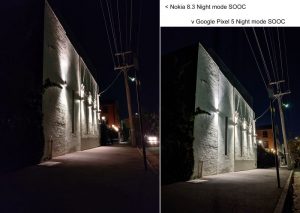 Let’s break down the marketing speak first. The marketing on Quad Pixel sensors is that 4 pixels are combined into one big pixel that can gather more light more effectively, and like magic you get better dynamic range of colour representation and better details in your photos. True? False? Neither really. It is not wrong and it is not exactly right.
Let’s break down the marketing speak first. The marketing on Quad Pixel sensors is that 4 pixels are combined into one big pixel that can gather more light more effectively, and like magic you get better dynamic range of colour representation and better details in your photos. True? False? Neither really. It is not wrong and it is not exactly right.
Space constraints in smartphones directly impacts on the image sensor size. Generally speaking, mobile image sensors have to compromise on image resolution for better low-light performance, or vice versa. Also, as it happens, higher megapixel count does not automatically result in better photo quality. Note how carefully I word this, because in the hands of a skilled photographer, “better photo” does not necessarily need to be of “better photo quality”. If you want to see just what I mean, have a look at what David Hobby from “Strobist” manages to do with a 2-megapixel Buzz Lightyear camera and three cheapo flash units!
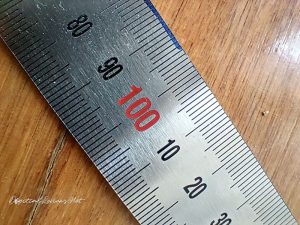 Anyways I digress. Quad pixel. Let me try to break down the technical into layman terms in 25 words or less. The technology behind this is the Bayer filter, a colourful mosaic of Red, Green and Blue filters that allows a digital sensor to capture colour photos. This takes care of what semiconductor pixels can’t do – making sure the light reaching each pixel is one of three primary colours rather than black and white. The “Quad Bayer filter” is really a regular Bayer filter, with new sensors that puts four pixels behind each colour square instead of one. So when we talk 64MP Quad Pixel technology, your output will be 16MP.
Anyways I digress. Quad pixel. Let me try to break down the technical into layman terms in 25 words or less. The technology behind this is the Bayer filter, a colourful mosaic of Red, Green and Blue filters that allows a digital sensor to capture colour photos. This takes care of what semiconductor pixels can’t do – making sure the light reaching each pixel is one of three primary colours rather than black and white. The “Quad Bayer filter” is really a regular Bayer filter, with new sensors that puts four pixels behind each colour square instead of one. So when we talk 64MP Quad Pixel technology, your output will be 16MP.
I could go into details on the 2.8 micron size pixels, but you guys would have fallen asleep or jumped ship already. So I am just going to leave it there … 64MP quad pixel sensor, 16MP size photo output by default.
Shooting modes of the Nokia 8.3 5G, aside from default, includes portrait, night, panorama, slow motion, time lapse, pro, video and a cinema mode.
In auto mode, the Nokia was capable of capturing some nice daytime shots in decent lighting. Switching between normal and ultra-wide mode is an easy tap on the indicator on screen, and viola you can cram more into the frame just like that. The colours are vivid and under good lighting conditions, there is heavy processing in the images which results in distracting over sharpening of details.
Just like the Google Pixel line, there is a night mode at your disposal. It is above average, allowing low light shots to be captured a little brighter than otherwise. Does it have a wow factor? Kind of. It was not mind blowingly great, there is notable noise in the image but overall if you are viewing it on a mobile screen through a social media channel then it works just fine. Don’t expect it to hold up to billboard size.
Portrait mode shows the blur in real time prior to the image capture, handy!
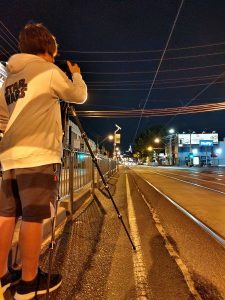 The macro game is somewhat disappointing, with forced over sharpening to bring out details that hurts my eyes to look at. The decision to go with a 2MP macro sensor limits the use case to more a “cursory” toy rather than a serious tool.
The macro game is somewhat disappointing, with forced over sharpening to bring out details that hurts my eyes to look at. The decision to go with a 2MP macro sensor limits the use case to more a “cursory” toy rather than a serious tool.
The depth sensor didn’t seem to have made much of the way of impact in the photos.
What is not clearly documented is how to make the most of the 64MP capabilities of the Nokia 8.3 5G. In order to push the limit, you will need to switch the camera app to the Pro mode. This is easily done either by the horizontal scroll options, or by pulling up on the shutter button. The latter option immediately gives you control of the White Balance, Depth, ISO, shutter speed and EV values. Additionally you can shoot in RAW format in Pro mode.
A feature not found in other camera apps I have used is the ability to watermark images on the fly. The Nokia camera app offers this functionality with the ability for a personalised message, afdd device info (hard coded), or personalised image. There are a number of template layout for the personalised message which is a nice touch for a phone geared for content sharing.
Also in the camera app menu, there is an option to save photos to HEIF format which is more efficient than the venerable JPEG. The industry at large is starting to see greater compatibility with this format.
I can’t seem to find a way to change the speed of time-lapse and slow mo videos.
Videography is where Nokia has put a lot of emphasis on, or in their words, taking cinematics to the next level. In addition to the standard, ultra-wide and macro settings, there are Action and Dual Sight and Cinema modes.
Running through the basics:
- Action results in better stabilised footage at a cost of image crop.
- Dual Sight splits the screen in two to show recording of both front and rear cameras simultaneously. It’s an awesome feature that Nokia has made available and it works brilliantly.
And to the top of the video mode, the new Cinema mode can capture footage at up to 4K 24 fps and 60Mbps with full manual exposure control and 7 preset effect settings. You can turn on H-log picture profile to maximise the dynamic range of the camera and to really leverage the metadata in post processing.
You can activate the H-Log view assist to check the effect in real time. Further Nokia provides a Cinema Editor app which has 10 preset grades and the ability to add Zeiss flares. This last one is a JJ Abrams wet dream come true where you can add in standard, blue or anamorphic flares. The app adds them in when required and is calculated by incoming light angle.
Also in the cinema mode, footage is captured in 21:9 aspect ratio in line with movies and option to toggle wind noise reduction.
In the hands of a skilled videographer, there is certainly a lot you can do with this phone.
Battery life
One of the bugbears of smart phones has always been battery life, and the Nokia 8.3 5G has a large display and 5G connectivity to power. The good news is that there is a 4500 mAh battery and it has lasted me through most days without recharging with moderate to high usage, I would generally have around 18% left in the tank. On a cruisy day it had plenty of juice left by the time I go to bed at stupid o’clock.
Nokia has added support for QuickCharge at 18W which is essential when there is such a large power pack, but there is no wireless or reverse charging. Both features could be handy but it is not a dealbreaker.
Call quality
Generally good with clear sound on both sides. I did run into the occasional problem on the speaker phone but that was mainly with one other person. To be perfectly honest my conversations with that one person usually goes along the lines of me repeating myself so he gets the message.
Otherwise I use my (numerous) Bluetooth headsets and earbuds so often that it is not really something I worry too much about.
 Other Features
Other Features
For those who pine for the days of the good old 3.5mm jack and awful bundled earbuds, this is the phone to rejoice with! The Nokia 8.3 5G comes complete with the now endangered list of technologies just to the right of the USB-C port. I will note that I did not try the provided wired earbuds so the “awful bundled earbuds” comment is generic.
Small thing, but the sim tray tells you which way it up. I have lost count the number of times I wondered if I was putting a sim tray in upside down with other phones.
There is a dual physical sim variant available, which in combination with the impressive 5G support should cover all bases.
The included USB cable is of the renowned Nokia quality. Myself and more than a few old tech guys would go to the ends of earth just to keep these because they never break.
Gripes
The dedicated Google Assistant Button is an in awful position where I am guaranteed to press it whenever I pick up the phone. It can be disabled but not remapped to something else. It is faster than saying OK Google, but I really dislike where it is located.
Photos taking in non-ideal daylight are over processed and sharpened which is unnecessary and distracting.
The fingerprint reader is fast, but there has been times when it just would not respond and I have to physically depress the power button to wake the phone.
This won’t affect everyone, but the microSD expansion slot is at the expense of the second sim slot.
Conclusions
Keeping in mind that the Nokia 8.3 5G is not a flagship device per se (nor is it priced in the stratosphere), it is a solid performer, although there are some shortcomings in the overall experience in particular the Google Assistant button. The device has Android enterprise recommendation, global coverage and 3 years of guaranteed security updates.
I had mixed feelings about the new look Nokia line up prior to this review, but I was also curious where they are at without committing to one for the next two to three years without a road test. After my evaluation period, I have to admit I am a bit torn. Had the Pixel been priced at a premium as it had been the past few years, the Nokia 8.3 5G would be a serious contender at a RRP of $899 and yes, there are deals to be had placing it far closer to the $700 mark.
There are a few reasons why the Nokia 8.3 5G is not an automatic yes for me. Firstly the photo quality, the hardware is there, the will is there, perhaps just a bit too much. It may come in handy for when a 00 is capturing top secret documents in any situation, but for us mortals, the photos processing can be too heavy handed for the general happy snaps. An update to the software surely can resolve this issue.
Secondly with the Pixel 5 being a direct competitor at a little more cost and the free unlimited “high-quality” uploads to Google Photos (which applies to all existing Pixels and will be grandfathered in on 1 June 2021), the Nokia 8.3 5G is a harder sell. The delay between announcement and actual launch has hurt Nokia somewhat.
Mission almost accomplished M. I would love to see a commitment to an additional major OS revision along with the benefits of further security updates. Because even if I upgrade within 12 to 24 months, it will be a perfectly good phone to pass down to my parents or my dependants. However this is limited by Google’s own support for older platforms.
Note the link provided is through Amazon Australia, and buying through them helps DigitalReviews so we appreciate you considering making your purchase there.
DRN would like to thank Nokia for their on-going support, stay tuned as we have two more handsets on our test bench.
Specifications
Design
Colours: Polar Night
Size: 171.90 x 78.56 x 8.99 mm
Weight: 227 g
Performance
Operating System: Android 10
RAM: 8 GB LPDDR 4x
CPU: Qualcomm Snapdragon 765G modular platform
Connectivity
Cable type: USB Type-C
SIM cards: Dual SIM model available
SIM card type: Nano SIM
Sensors: Ambient light sensor, Proximity sensor, Accelerometer (G-sensor), E-compass, Gyroscope, Power button fingerprint sensor
Keys: The Google Assistant button
Cameras
Rear cameras: PureView quad camera imaging system with ZEISS Optics. 64 MP sensor, 12 MP sensor with ultra-wide lens, 2 MP depth sensor and 2 MP sensor with macro lens
Dual high CRI Rear flash
Front-facing camera: 24 MP
Other: ZEISS Optics
Battery
Battery size: 4500 mAh
Charging: 9V / 2A
Storage
Internal storage: 128 GB
MicroSD card slot support up to 512 GB
Display
Size and type: 6.81″ FHD + PureDisplay
Display ratio: 20:9
Audio
3.5 mm headphone jack
FM radio receiver (headset required)
OZO audio
Network and connectivity
Network speed: LTE Category 18, 5G NSA/SA and DSS supported
5G NR: n1, n2, n3, n5,n7, n8, n28, n38, n40, n41, n66, n71, n78
GSM: 850, 900 35 dBm
GSM: 1800, 1900 32 dBm
WCDMA: 1, 2, 4, 5, 8 25 dBm
LTE: 1, 2, 3, 4, 5, 7, 8,12, 13, 17, 20, 28, 38, 39, 40, 41, 66, 71
WiFi: 802.11 a/b/g/n/ac
NFC
Bluetooth® 5.0
GPS/AGPS+GLONASS+Beidou


